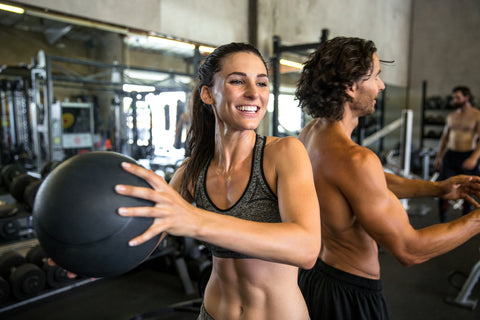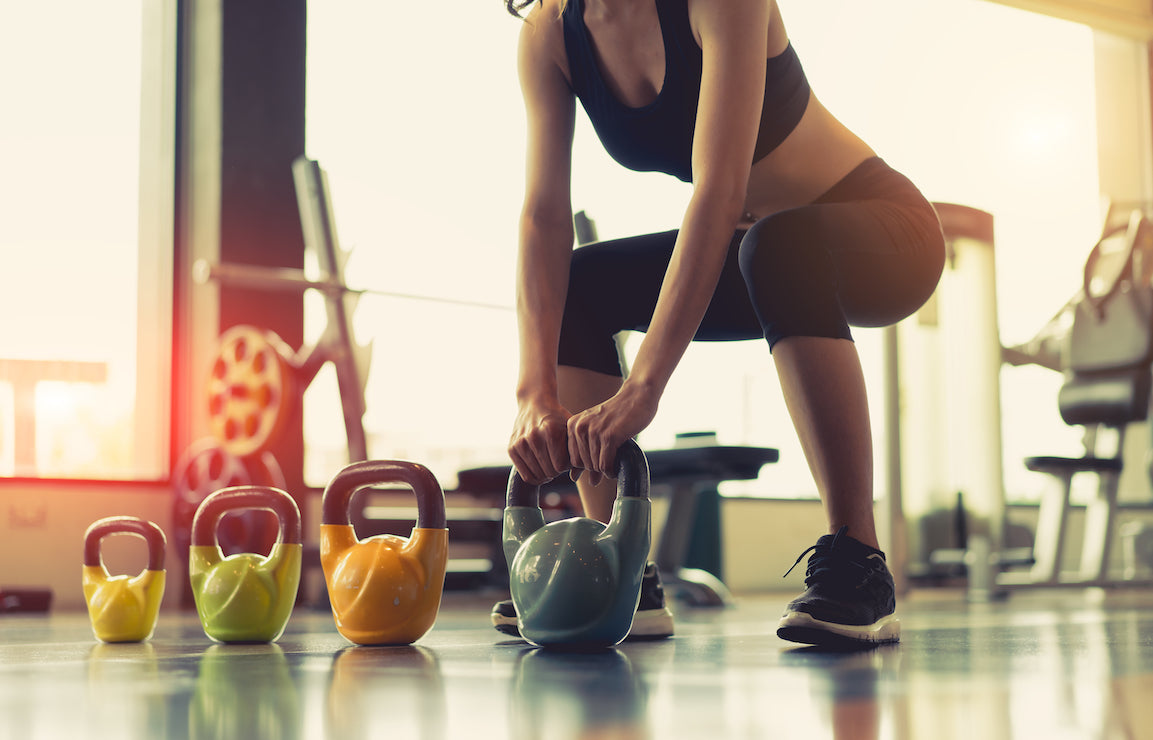

FREE SHIPPING AT $150
YOU'VE EARNED FREE SHIPPING!
FREE SHIPPING AT $150
YOU'VE EARNED FREE SHIPPING!
March 01, 2020 9 min read
You can't spell legendary without leg day.
Are you a basketball or football player, or a runner? Do you practice any sport that requires sudden changes in movements? Then you already know about the importance of the single-leg Romanian deadlift. This very vigorous exercise develops the leg strength needed to be explosive when it's important.
Its main focus is on glutes and hamstrings, the primary drivers of fiery movements.
Why is this significant? Because in many activities, hip extension holds more control of a movement than knee flexion. Since it requires balancing on one leg at a time, the emphasis of the single-leg RDL is on stability, so it helps to optimize the performance and body control. It also eliminates strength imbalances on the sides of the body.
All of these make the single-leg Romanian deadlift an essential exercise for any athlete and a staple in functional strength training.
The single-leg RDL should be a part of every strength and conditioning program, as one of the best all-round exercises for improving long-term strength, health, and glute aesthetics.
Romanian Deadlift was invented by a Romanian weightlifter Nicu Vlad and his coach Dragomir Cioroslan, as a way to increase back strength to perform other weightlifting exercises. It has been first recognized by U.S. Olympic Weightlifting Coach Jim Schmitz.
Schmitz's U.S. Weightlifting team was attending a weightlifting clinic at his San Francisco gym in 1990. As it happened, the clinic was led by Vlad and Cioroslan. During his stay at the clinic, Schmitz noticed Vlad's form of deadlifting and asked him to present it to his team.
Vlad was glad to demonstrate, but he still had no name for his new technique. Finally, Schmitz decided to name it the Romanian deadlift, in honor of the creators.
Later came the variations, which include the single-leg Romanian deadlift.
The Romanian deadlift's popularity had some effect on the stiff leg deadlift form. Currently, the stiff-legged deadlift is performed like the Romanian deadlift, with a straight back. Historically, it was presented with a rounded back. The aim was to increase the stretch on the hamstrings. This change in form is most likely why the stiff leg deadlift and Romanian deadlift are hard to distinguish nowadays.
What is a deadlift? There's a barbell on the floor, and you pick it up, taking care to maintain good posture.
If you want a higher degree of strength-building for your hamstrings and glutes, the single-leg deadlift is for you.
When performing it, your hips are pushed more to the rear, which provides better hip joint rotation. Your hips will flex more, thus working the glutes and hamstrings to a better degree.
Old-fashioned, two-footed deadlifts are a great way to train the glutes and hamstrings. They build muscle strength, size, and power. Due to the less stable performing position, the single-leg Romanian deadlift can't be loaded as heavy as the more traditional forms.
The single-leg RDL offers a lot of other advantages that other variations lack, with a lower risk of injury.
It develops pelvic control while the legs are separate and moving independently of each other, which mimics running, sprinting, carrying odd objects, and crawling patterns. In short, it helps with everyday life.
The single-leg Romanian deadlift adds a component of balance to the exercise.
You challenge your static balance merely by standing on one leg. When you incorporate the Romanian deadlift movement on one leg, it adds an element of challenge for your dynamic balance. Exercises that are challenging your dynamic balance are more functional than static balance exercises.
If you really want to feel the difference in muscle activation between the stiff leg deadlift vs. Romanian deadlift vs. single-leg RDL, try bending over to touch your toes. Repeat once with your legs straight, once with your knees slightly bent and once while balancing on one leg.

The deadlift varies in hip hinge patterns. The hip hinge is a way to stabilize the spine and pelvis under load while bending over forms. It forms the basis of many popular strength training exercises: bent-over rows, squats, deadlifts, kettlebell swings, good mornings, t-bar rows, and bent over rear delt raises. You need to make a proper hip hinge even to pick up dumbbells off the floor or out of the lower rack.
The hip hinge is essential, but also one of the difficult movements to learn for beginning lifters. That is partly because the action requires strength and coordination throughout the entire posterior chain. Even some experienced lifters have trouble 'feeling' these muscles properly. The glutes, erectors, and hamstrings must work together to allow the torso to drop forward while maintaining a neutral spine and pelvis.
The single-leg RDL is a hinge movement. It can be done with a barbell, one or two dumbbells or kettlebells, a steel mace, sandbag, or any training implement you prefer. You stand on one leg, hold a load in one or both hands, and bend your hips back while keeping a straight spine.
Due to its versatility, the single-leg Romanian deadlift can be used everywhere in a workout program from the warmup to the finisher.
When the single-leg RDL exercise is done correctly, it makes it possible for the whole posterior chain (glutes, hamstrings, calves, back extensors) to be activated with one functional movement. Unfortunately, many lifters still limit their leg training to squats, leg press, and leg extension variations. These exercises will certainly develop the quads. Their disadvantage, compared to Romanian deadlift, is the neglect of the essential element in developing a muscular and powerful physique: the hamstrings.
Look at the list of muscles used for performing a single-leg RDL:
On top of it all, another great feature of the single-leg RDL is that it serves as a warmup by itself. You can use it to prepare your lower body for a heavy workout. At the same time, you stretch out your hamstrings. Win-win situation.
If you are brand new to this exercise, begin without weight, just with a fair balance and reach. Use an object to reach for and focus your eyes on, like a barbell on a stand. You may choose later to add weight for resistance or keep training with no equipment for balance improvement. In both ways, the single-leg RDL is a great technique. Just be sure to keep in mind these key points:
Weightless performing is an excellent way to train your body balance.
If you have any trouble with the balance component, try staggered-stance RDL. That means you simply keep the foot of your non-working leg on the floor as you perform the hip hinge movement. You'll get a great stretch in your butt and hamstrings without having to worry about tipping over. To progress toward doing the move one-legged, try to hold on to something like the support beam of a power rack.

This is a variation of the simple exercise with the addition of a small weight.
Add a dumbbell to your single-leg RDL exercise to increase resistance. That will help you train the balancing skill. For this exercise, use one dumbbell/kettlebell instead of two. You need to have good balance to hold the dumbbell upright instead of dropping it to to the ground,
Make sure to balance on the leg opposite to the hand in which you hold the dumbbell. You need to lower the dumbbell toward the ground as you drive your hip and leg back, instead of reaching out forward.
The dumbbell must not hit the ground during this exercise, so make sure to choose the weight you're comfortable holding.
Balance and Coordination: Standing on one leg activates muscles from the hip down. This process is supposed to keep you from falling. On higher-rep sets, you may experience the bottoms of your feet burning from single-leg RDL's, as you struggle to maintain balance. Training stability on one leg is especially important for playing sports that have you running and jumping. At the same time, you're training a hip hinge. The more you flex and extend your hips powerfully, one leg at a time, the faster you will run and the higher you will jump, with a quicker change of direction.
Stronger Posterior Chain: The single-leg RDL works all the same muscles like any other deadlift. All of those will provide excellent training for your glutes, hamstrings, lats, and spinal erectors. Single/leg RDL exercise adds a greater range of motion, activating more of the hamstrings. It optimizes body control and eliminates strength imbalances on the sides of the body. It also forces you to draw your shoulders back into a better posture position. Compared to the traditional lifts, what this training lacks in a load it compensates with range.
Like yoga, the single-leg RDL improves how you move and carry your body. Learning to hinge properly is necessary for working out safely. Otherwise, your lower back will suffer under any load you're lifting. That road leads to injuries. Don’t take it!
When you perform the single-leg RDL, if you don't hinge correctly, you'll feel it in your back and eventually lose balance. It's virtually impossible to do the Single-Leg RDL if you can't hip hinge properly. That makes the exercise a great learning tool.
Once you are used to doing this exercise properly, you can expect a multitude of physiological improvements. Strength, power, mobility, stability, balance, posture, motor control, symmetrical loading, breathing patterns, and coordination will all improve. You will notice the better performance of squats, broad jumps, vertical jumps, and deadlifts, as well as agility, and running speed. Your joints, including your hips, knees, ankles, low back, and feet, will also benefit. At the same time, you'll probably eliminate a big portion of dysfunction in your foot and ankle region.
It's a whole body, complete, functional exercise. It can also be used for rehabilitation, for strength, and for conditioning purposes. It's a popular exercise in physical therapy due to its ability to work the entire lower extremity posterior chain, while simultaneously challenging one's balance.
Strength and power athletes, as well as beginners, can benefit from increased unilateral strength. In short, single-leg RDL is a great exercise, highly recommended to anyone and everyone.
